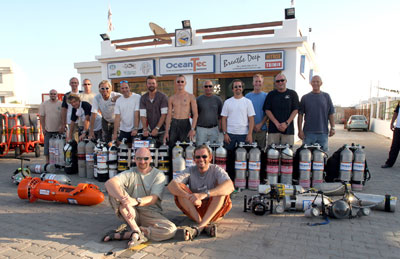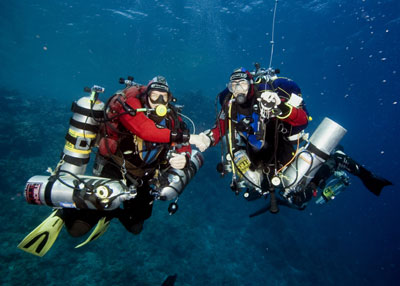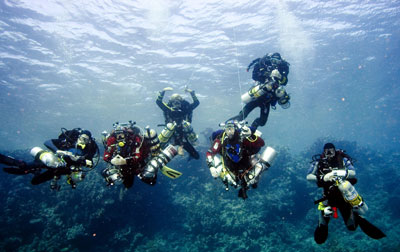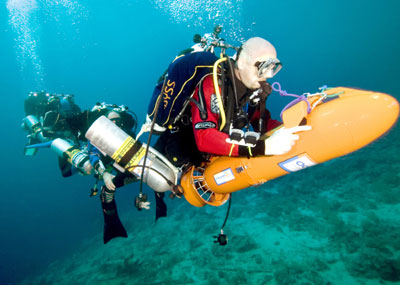
|
NEW WORLD RECORD FOR THE DEEPEST WRECK DIVE 9-12-05 205 metres |
||||||||||||||||||||||||||||||||||||||||
|
Maximum
depth :205 metres
Total
dive run time: 205 minutes
Time on
the wreck: 6 minutes
7 / 66
Bottom mix
16 / 43
Intermediate Trimix
52/ 15 Hyperoxic
travel / lean deco. gas
80% EANx
deco. gas
|
The Team |
||||||||||||||||||||||||||||||||||||||||
|
|
Leigh
Cunninghams, (left), rig:
Manifolded twin 18s with twin 12s as a quad, plus 2 x 15 litre slings
Mark
Andrews, (right ), rig: |
||||||||||||||||||||||||||||||||||||||||
|
A jubilant 'shallow
support' team |
|
||||||||||||||||||||||||||||||||||||||||
|
|
Job jobbed. Best catch the last bus home. | ||||||||||||||||||||||||||||||||||||||||
|
The complete story from Mark: I checked in at Gatwick airport on Saturday 3rd December with three very large dive bags containing all the necessary equipment to make a descent hopefully to the deepest wreck ever dived. Astraeus flights and Red Sea.com were more than helpful with this project and made sure that my check in went as smooth as possible, considering one of the bags contained a Farralon ride on scooter this was a great relief. I arrived at Sharm airport to be met by my deep diving buddy Leigh Cunningham who drove me to my hotel. Leigh was describing to me how the last two weeks prior to my arrival had seen perfect conditions for diving ‘Yolanda” reef, with very little wind and smooth seas, of course with the luck we have been having with this project it was bound to all change. I cast my mind back to May when we started the project, all went well until I received a dose of Pharaohs revenge and spent the last part of the week wrapped up in bed while Leigh discovered the bow of the wreck in 145m. After a good nights sleep I travelled down to Trafco jetty to meet the dive boat supplied for the project by Seamus and Anna of Colona Dive Centre who had also supplied the boat previously. The team were already aboard busy preparing equipment and making ready for Leigh and myself. The team consisted of multi national technical divers from Sharm-El-Sheikh and Dahab, Most of whom I had worked with in the past and some new to me all sharing a common interest in a passion for technical diving and to assure that this week would be a success. The weather was holding out for us and we steamed out into flat blue seas with little to no wind. The first day was spent at a local dive site making the deep dive rigs and ensuring all the equipment was working, as it should. I had decided to use my triple 300 bar Worthington Carbon/steel combination cylinders for this dive, this would allow me to wear one less cylinder than Leigh and offer a less dramatic profile in the water. Leigh would wear his trademark dive rig of twin twenty litre cylinders with a twelve litre strapped either side making and two fifteen litre tanks as stages thus making a six tank configuration. The problem I had with my rig was that there is nowhere in the Sinai that has a 300 bar compressor system, until now! Chad Clarke, a familiar face in Sharm has opened an all new pumping and gas blending station next to Trafco jetty (Ocean Tec) and agreed especially for this project to install a 300 bar system, how’s that for service? You are a star Chad! Leigh and myself spent the first day tinkering with the dive rigs and the team took the opportunity to study them and fully familiarise themselves with their operation as they will be responsible for ensuring that we have all the right equipment in the right place prior to each dive. Later in the day we made a 100m dive to ensure all was well both with us and the rigs. The second day we were out to the dive site itself and made a further 100m dive, this time we had the full dive team in the water simulating the big dive itself. Apart from diving to over 200m the hardest part of this dive is that is all done with no shot lines, free descent and free ascent being the order of the day. The safety divers need to be experienced in Blue water diving with no visual reference of lines or reefs. Both Leigh and myself had decided not to have safety divers deeper than 30m on the big dive itself due to the fact that we would be carrying all necessary gas for the entire dive and would prefer to be alone during the busier parts of the ascent which require great concentration of ascent speed and gas switches. The idea was to deploy DSMB’s at 30m and each of us would have two support divers descend down the line to greet us with spare gas if needed and in water hydration packs. We made a further days diving on the site again to 100m with the whole team, everything was going very well, the weather was holding, the team were exceptional and Leigh and myself were both in great condition for the dive. Tuesday 6th after the last air dive saw us in the gas blending station Ocean Tec at Trafco preparing for the first mixed gas dive the following morning. We hit a major problem within minutes of starting, although we had a 300 bar compressor we had overlooked the fact that we needed a 300bar decanting whip for the blending panel, the mood changed as we tried everything we could to mate various parts lying around the centre to make a workable whip. Just as despair was setting in Chad came to the rescue and called a local engineer who came down to the centre, we showed him a 300 bar spin tube and the high pressure decanting hose and simply stated that we needed “this bit to fit onto this bit” this was met with a little scratch of the head followed by “no problem, 2 hours” This was 8pm in the evening, can you imagine this situation in the UK! We decided to have a break and went to dinner, an hour later we received a call from Chad saying that the part was here, we paid the bill and hurried back to the centre, I must admit I had my doubts as the fitting needed an odd coupling to ensure a good fit. We put it together and it worked a treat, not even a slight leak. The following morning we headed out to “Yolanda Reef” again the weather and sea perfect. This time we had left the dive plan with Doctors Adel and Ahmed at the Sharm Hyperbaric facility that would follow our progress and support the project with medical assistance. We agreed in return for this that we would visit the chamber after each dive and undergo some tests for their studies. We also had the Sharm Search and Rescue centre supporting us with a rescue boat and paramedic staff, all these guys provides their services for free to us and we are deeply in your debt, many thanks. The plan for the day was a dive to 150m to relocate the bow of the wreck and plot the position with GPS ready for the big dive. We already had a good idea where we needed to drop and Vern our GPS man was ready when we dropped off the back of the boat. Snorkelers entered the water and checked our dive rigs for leaks, this completed we descended into the blue on our 45/12 travel/intermediate decompression gas. At 10M we gave each other the gas switch signal and switched to our back gas of 9/57. We both settled into the descent and enjoyed the ride. We reached 100m and there was still no sign of the reef wall just dark water all around, I turned on my Metal Sub 200W HID and shone it in all directions but nothing, then at 120M the light picked up the funnel of the wreck lying off to one side on the steep reef wall. We had landed about 50m to the right of the main wreckage and made the swim across and down to 150m to be met by the bow of the wreck. The Metal Sub lit up the wreckage like it was in a football stadium and we could clearly see the debris scattered all around the steep reef wall. I shone my dive light down the length of the wreck and watched as she seemed to go on forever down the steep slope, we had no idea how far down she would reach. We were both amazed at how entrenched in sand she had become, the bow was merely a few feet proud of the sea bed being covered in years of sand fall delivered from the strong currents that run between the two reef plates high above the wreck. Our bottom time soon ran out, we both gave the up signal and waved goodbye to the wreck. As we ascended the reef quickly disappeared from view and we were back in the blue. We reached our first gas switch depth at 75M (17/25) and signalled each other to assure we both made the switch. Ascending in the blue can give some divers severe vertigo and should not be contemplated without a good deal of experience in shallow water first, it requires a lot of concentration and discipline and you can easily find yourself in violation of ascent speeds and run times. At 30M we made our next switch (45/12) and deployed out DSMBs to show the surface support our position in the water. As mentioned the currents can be very strong here and we are never sure just where we will be when we deploy the DSMBs. A lookout is always scanning the sea from the dive boat at the time we state on the dive plan to deploy. Within 5 minutes we were joined by two safety divers each, one carrying the Farallon scooter to help us get back to the reef wall for a more pleasant decompression phase. The safety team kept a careful eye on us as we made our final gas switch to 80% Nitrox. After just over two hours in the water we reached the surface and were helped back to Colona dive boat. Upon reaching Trafco jetty we left the team and went over to see DR Adel and Ahmed in the Sharm Hyperbaric facility so that they could run some tests. They had a new machine called a “slit scanner” that can detect minute bubble formation in the tear film on the divers eyes. We were both given a clean bill of health and returned to Ocean Tec blending station to give a hand pumping all the gas for the big dive on Friday. Thursday offered a chance to relax a little and we spent the day on the Colona dive boat tinkering with the dive rigs and analysing all the gas mixes. We made a final dive plan and briefed the team to each person’s responsibilities. Friday morning saw yet another perfect day with the sun shining brightly and the see with barely a ripple. As we arrived at the dive site the search and rescue team arrived and moored up alongside the Colona dive boat, these guys offer us a fantastic service and a speedy evacuation should the worst happen. Once prepared we positioned the dive boat over what we believed to be the correct position based on the previous 150m dive, the horn sounded and we dropped into the water. One of the safety divers performed a quick but thorough leak check on our dive rigs, we signalled each other to descend and slipped below the calm blue water. We descended the initial 20M on our travel/lean deco mix of 52/15 before signalling each other to switch to our bottom mix of 7/66. Once switched we relaxed and descended at a steady 50m per minute until reaching 120M where we slowed to 30M, this reduction in speed helps lessen the risk of high pressure nervous syndrome (HPNS) bought on by rapid pressurisation of helium (fast descent). This drop was perfect, the bow of the wreck came into view at 130M and we descended onto the wreck itself slowly swimming down along the length of its remains. As I reached 195M a large bang went off behind my left ear and my dry suit inflator stopped working, I came to a halt at 205M as measured on our dive computers a Suunto D9 and a Nitek 3, as we levelled we could see that we were just under the stern of the wreck and that the ship was perched on a ledge roughly 40M wide. Beyond this a vertical wall descended into the abyss. The wreck had slid down the reef walls and slammed into this small ledge stern first, the rest of the wreck crumpled under the force and there she rests today slowly filling with sand. As we swam under the stern my pressure gauge imploded on my intermediate Trimix (16/43), luckily no leaks occurred and it just filled with water, one of Leighs computers imploded squashing the LCD screen (Vytec). We finished the bottom time by swimming up the other side of the wreck and looking at all the scattered wreckage that lay around the site. We gave each other the up signal after a bottom time on the wreck of five and a half minutes and slowly raised back into the dark blue water getting a fantastic view of the wreck as we did so. During the initial ascent we prepared our intermediate Trimix (16/43) for the gas switch but my regulator was not responding, I tried to purge but had no response, I maintained a steady 10m per minute ascent rate as I mulled over the thought of having to miss all my deep stops and ascend to the point at which I could switch to my lean Trimix decompression gas, this was not a good option and would have almost certainly resulted in a long stint in the chamber. We had plenty of spare gas on the dive boat but this was of no help as I ascended toward the gas switch. As I approached 100m I again purged the regulator and to my amazement a little air escaped from the mouthpiece followed by a loud gushing sound and then all was operational again, I safely made my gas switch at 84M along with Leigh and a large sigh of relief. We both ascended following the decompression schedule precisely and deployed our DSMBs at the forty-second minute as planned from a depth of 30M. We were soon joined by the safety divers eager to know if the dive was a success, a big OK and large smiles from Leigh and myself confirmed the success, We ascended to 27M for the next gas switch of 50/15 which could not come soon enough for me as the pressure gauge on my 16/43 was still reading 300 bar after the implosion. The Farallon scooter arrived and we slowly made our way back towards the reef wall to continue the decompression. We made our final switch onto our 80% Nitrox and completed the 205 minutes of decompression with no further problems. Once back on the dive boat we compared broken bits of kit and discussed the truly awesome dive we had just undertaken. The boat was alive with happy smiling faces and everyone shaking hands. Louise one of the photographers had made us a chocolate cake to celebrate the dive and all the team and crew tucked in during the return to shore. Once at the jetty Leigh and myself went back over to the chamber for further tests and again given a clean bill of health. Back at Ocean Tec we rejoined the dive team for the official team photographs and to thank everyone for their support. The team is often overlooked in these projects but Leigh and myself have had the honour to work with the finest support team that we could hope to have and cannot thank you all enough. Without you this entire dive would not have been achieved. Leigh and myself would like to thank the following people:
Dive equipment
specifics: Leigh: Mark Andrews and Leigh Cunningham are both Instructor trainers for the professional scuba association and teach a range of technical diving in the Red Sea they can be contacted at: Mark Andrews e-mail: deep_Andrews@yahoo.co.uk Leigh Cunningham e-mail: highpp02@yahoo.com |
|||||||||||||||||||||||||||||||||||||||||



